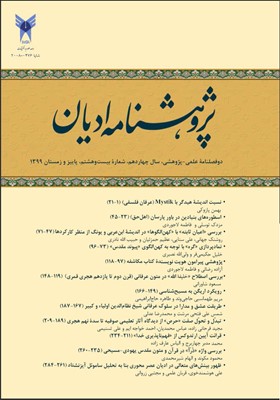ظهور بینشهای متعالی در ادیان عصر محوری بنا به تحلیل ساموئل آیزنشتاد
محورهای موضوعی : مسیحیت
علی هوشمندخوی
1
*
,
قربان علمی
2
![]() ,
مجتبی زروانی
3
,
مجتبی زروانی
3
1 - دانشجوی کارشناسی ارشد ادیان و عرفان تطبیقی دانشگاه تهران
2 - دانشیار گروه ادیان و عرفان تطبیقی، دانشگاه تهران، تهران، ایران
3 - دانشیار گروه ادیان و عرفان تطبیقی، دانشگاه تهران، تهران، ایران
کلید واژه: عصر محوری, بینشهای متعالی, رستگاری, ماکس وبر, هویت جمعی, حاکمان سکولار,
چکیده مقاله :
در این مقاله آرای ساموئل آیزنشتاد در شرح ظهور بینشهای متعالی در ادیان عصر محوری، به روش توصیفی-تحلیلی بررسی شده است. آیزنشتاد مهمترین دگرگونی دینی در عصر محوری را ظهور بینشهای متعالی در ادیان یهودی، کنفوسیوسی، هندوئی و بودائی میداند. بنا به ارزیابیهای او، بینشهای متعالی ناظر به تمایز میان دو عرصۀ نظم متعالی (پالوده) و نظم دنیوی (آلوده) بودند و کوشش برای رفع تنش میان آنها منجر به نهادینهشدن چند جهتگیری مختلف در ادیان عصر محوری شد: جهتگیری اینجهانی (انجام درست امورات دنیوی) در دین کنفوسیوسی؛ جهتگیری آنجهانی (کنارهگیری از امور دنیوی به منظور رستگاری) در ادیان هندوئی و بودائی؛ جهتگیری توامان اینجهانی و آنجهانی (قوانین شریعتمدار، جهتگیری نیایشی، دستورالعملهای آئینی و مَنهیات اخلاقی) در دین یهودی. در نظر آیزنشتاد نهادینهشدن این رویکردها منجر به بازسازی نظام دنیوی در برخی جنبهها شد: پدیدارشدن حاکمان سکولار که در برابر نظام متعالی پاسخگو و در برابر اَعمالشان مسؤول بودند؛ و مجزاشدن هویت جمعی مبتنی بر تقدّس از هویتهای مبتنی بر مدنیّت و خاستگاه مجزا.
In this paper, the views of Shmuel Eisenstadt about the emergence of transcendental visions in the religions of axial age are analyzed in a descriptive-analytic method. Eisenstadt considers the most important religious transformation of the axial age to be the emergence of transcendental visions in Judaism, Confucianism, Hinduism, and Buddhism. In his analysis, transcendental visions distinguished between two realms of transcendental order (refined) and mundane order (polluted), and all attempts for the resolution of the tension between transcendental order and mundane order led to the institutionalization of some different orientations in axial age religions: this-worldly orientation (proper performance of worldly duties) in Confucianism; other-worldly orientation (act of renunciation) in Hinduism and Buddhism; and combination of this and other-worldly orientations (legal rules, cultic orientation, ritual prescriptions and ethical injunctions) in Judaism. In Eisenstadt's viewpoint, the institutionalization of these orientations led to the reconstruction of mundane order in some aspects: Appearance of secular rulers who were partially responsive to the transcendental order; and the separation of collective identity based on sacredness from the other types of collective identities based on civility and primordiality.
_||_

